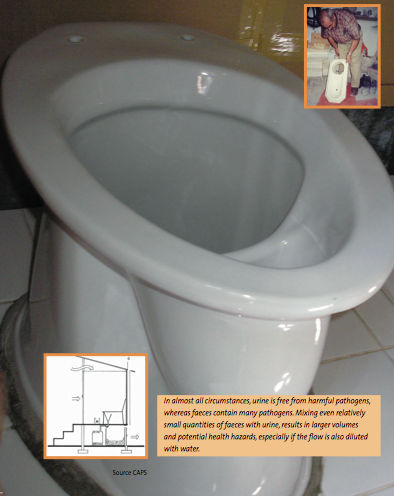Urine Diverting Dry Toilet
|

|
|
| |||||||||||||||

A Urine Diverting Dry Toilet (UDDT) is a toilet that operates without water and has a divider so that the user, with little effort can divert the urine away from the faeces.
The UDDT toilet is built such that urine is collected and drained from the front area of the toilet, while faeces fall through a large chute (hole) in the back. Depending on the Collection and Storage/Treatment technology that follows, drying material such as lime, ash or earth should be added into the same hole after defecating. Men, as well as women, need to sit while urinating to ensure that the urine is diverted into the correct channel.
It is important that the two sections of the toilet are well separated to ensure that a) faeces do not fall into, and clog the urine collection area in the front, and that b) urine does not splash down into the dry area of the toilet.
Water used for anal cleaning must be kept separate in order not to dilute faeces or pollute urine with pathogens. This requires a separate facility for anal cleaning. Small amounts of anal cleaning water can be infiltrated. Larger volumes need to be treated (together with grey water) to prevent ground water pollution.
There are also 3-hole separating toilets that allow anal cleansing water to be separated from the urine and the faeces into a third, dedicated hole. It is important that the faeces remain separate and dry. When the toilet is cleaned with water, care should be taken to ensure that the faeces are not mixed with water.
Both a pedestal and a squat slab can be used to separate urine from faeces depending on user preference. Urine diverting dry toilets can be made out of ceramic, ferro-cement, fibre-enforced materials, or strong, durable, plastic and painted wood. It is important that the surface is smooth and hardened.
| Advantages | Disadvantages/limitations |
|---|---|
| - Does not require a constant source of water - No real problems with odours and vectors (flies) if used and maintained correctly (i.e. kept dry) - Can be built and repaired with locally available materials - Low capital and operation costs - Large scale nutrient recovery is a realistic possibilty. |
- Requires education and acceptance to be used correctly - Is prone to clogging with faeces and misuse -Special child seats have to be provided to keep their urine and faeces separate. |
Adequacy
The UDDT is simple to design and build using such materials as concrete and wire mesh or plastic. The UDDT design can be altered to suit the needs of specific populations (i.e. smaller for children, people who prefer to squat, etc.) They are appropriate for almost every climate.
Health Aspects / Acceptance
The UDDT is not intuitive or immediately obvious to some users. At first, users may be hesitant about using it and mistakes (e.g. faeces in the urine bowl) may deter others from accepting this type of toilet as well. Education and demonstration projects are essential in achieving good acceptance with users.
Maintenance
A UDDT is slightly more difficult to keep clean compared to other toilets because of both the lack of water and the need to separate the solid faeces and liquid urine. For cleaning, a damp cloth may be used to wipe down the seat and the inner bowls. Some toilets are easily removable and can be cleaned more thoroughly. No design will work for everyone and therefore, some users may have difficulty separating both streams perfectly which may result in extra cleaning and maintenance.
Faeces can be accidentally deposited in the urine section, causing blockages and cleaning problems. As well, urine pipes/fittings can become blocked over time and may require occasional maintenance.
This is a waterless technology and water should not be poured down the toilet. As well, urine tends to rust most metals; therefore, metals should be avoided for the construction and piping of the UDDT.
Movie
Manual - How to build
For more information on Dry Urine Diversion Toilets read this document
References and external links
- Elizabeth Tilley et.al (2008). Compendium of Sanitation Systems and Technologies (low res version). Department of Water and Sanitation in Development Countries (Sandec) at the Swiss Federal Institute of Aquatic Science and Technology (Eawag). (Provides a full overview of sanitation systems.)
- Morgan, P. (2007). Toilets That Make Compost: Low-cost, sanitary toilets that produce valuable compost for crops in an African context. Stockholm Environment Institute, Sweden. (Provides step-by step instruction on how to build a UDDT using a plastic bucket and how to construct a urine diverting squat plate.)
- Netherlands Water Partnership (NWP) (2006). Smart Sanitation Solutions. Examples of innovative, low-cost technologies for toilets, collection, transportation, treatment and use of sanitation products. NWP, Netherlands. (Provides country specific data and links for further information.)
- Winblad, U. and Simpson-Herbert, M. (2004). Ecological Sanitation. Stockholm Environment Institute, Sweden. Available: www.ecosanres.org (Provides a good, general overview of different types of UDDTs – see especially page 59.)
- General information www.gtz.de/ecosan
- General information www.ecosanres.org
- General information www.ecosan.nl
- South Africa www.csir.co.za
- Scope, India Urine diverting dry toilet in schools
